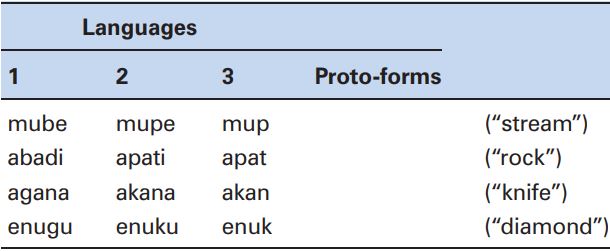


 Grammar
Grammar
 Tenses
Tenses
 Present
Present
 Past
Past
 Future
Future
 Parts Of Speech
Parts Of Speech
 Nouns
Nouns
 Verbs
Verbs
 Adverbs
Adverbs
 Adjectives
Adjectives
 Pronouns
Pronouns
 Pre Position
Pre Position
 Preposition by function
Preposition by function 
 Preposition by construction
Preposition by construction
 Conjunctions
Conjunctions
 Interjections
Interjections
 Grammar Rules
Grammar Rules
 Linguistics
Linguistics
 Semantics
Semantics
 Pragmatics
Pragmatics
 Reading Comprehension
Reading Comprehension|
Read More
Date: 2024-09-06
Date: 5-3-2022
Date: 4-3-2022
|
Word reconstruction
Looking at a non-Indo-European set of examples, we can imagine receiving the following data from a linguist recently returned from an expedition to a remote region of the Amazon. The examples are a set of cognates from three related languages, but what would the proto-forms have looked like?

Using the majority principle, we can suggest that the older forms will most likely be based on language 2 or language 3. If this is correct, then the consonant changes must have been [p] → [b], [t] → [d] and [k] → [ɡ] in order to produce the later forms in language 1. There is a pattern in these changes that follows one part of the “most natural development principle,” i.e. voiceless sounds become voiced between vowels. So, the words in languages 2 and 3 must be older forms than those in language 1.
Which of the two lists, 2 or 3, contains the older forms? Remembering one other “most natural development” type of sound change (i.e. final vowels often disappear), we can propose that the words in language 3 have consistently lost the final vowels still present in the words of language 2. Our best guess, then, is that the forms listed for language 2 are closest to what must have been the original proto-forms.
|
|
|
|
دخلت غرفة فنسيت ماذا تريد من داخلها.. خبير يفسر الحالة
|
|
|
|
|
|
|
ثورة طبية.. ابتكار أصغر جهاز لتنظيم ضربات القلب في العالم
|
|
|
|
|
|
|
بالصور: تزامنا مع ختام فعالياته.. ممثل المرجعية العليا يشارك في المحفل القرآني المركزي في الصحن الحسيني الشريف
|
|
|